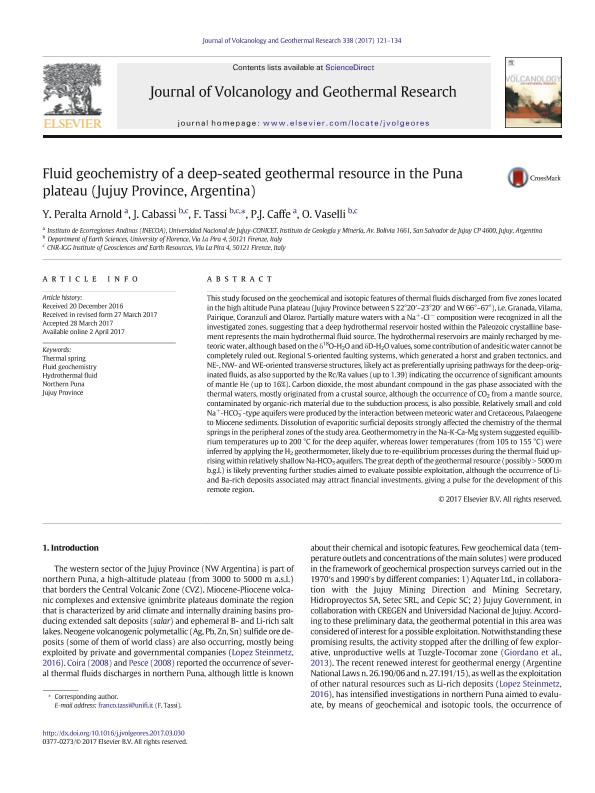Mostrar el registro sencillo del ítem
dc.contributor.author
Peralta Arnold, Yésica Jael

dc.contributor.author
Cabassi, J
dc.contributor.author
Tassi, Franco

dc.contributor.author
Caffe, Pablo Jorge

dc.contributor.author
Vaselli, O.
dc.date.available
2018-05-21T17:37:14Z
dc.date.issued
2017-04-02
dc.identifier.citation
Peralta Arnold, Yésica Jael; Cabassi, J; Tassi, Franco; Caffe, Pablo Jorge; Vaselli, O.; Fluid geochemistry of a deep-seated geothermal resource in the Puna plateau (Jujuy Province, Argentina); Elsevier Science; Journal of Volcanology and Geothermal Research; 338; 2-4-2017; 121-134
dc.identifier.issn
0377-0273
dc.identifier.uri
http://hdl.handle.net/11336/45767
dc.description.abstract
his study focused on the geochemical and isotopic features of thermal fluids discharged from five zones located in the high altitude Puna plateau (Jujuy Province between S 22°20′–23°20′ and W 66°–67°), i.e. Granada, Vilama, Pairique, Coranzulí and Olaroz. Partially mature waters with a Na+-Cl− composition were recognized in all the investigated zones, suggesting that a deep hydrothermal reservoir hosted within the Paleozoic crystalline basement represents the main hydrothermal fluid source. The hydrothermal reservoirs are mainly recharged by meteoric water, although based on the δ18O-H2O and δD-H2O values, some contribution of andesitic water cannot be completely ruled out. Regional S-oriented faulting systems, which generated a horst and graben tectonics, and NE-, NW- and WE-oriented transverse structures, likely act as preferentially uprising pathways for the deep-originated fluids, as also supported by the Rc/Ra values (up to 1.39) indicating the occurrence of significant amounts of mantle He (up to 16%). Carbon dioxide, the most abundant compound in the gas phase associated with the thermal waters, mostly originated from a crustal source, although the occurrence of CO2 from a mantle source, contaminated by organic-rich material due to the subduction process, is also possible. Relatively small and cold Na+-HCO3−-type aquifers were produced by the interaction between meteoric water and Cretaceous, Palaeogene to Miocene sediments. Dissolution of evaporitic surficial deposits strongly affected the chemistry of the thermal springs in the peripheral zones of the study area. Geothermometry in the Na-K-Ca-Mg system suggested equilibrium temperatures up to 200 °C for the deep aquifer, whereas lower temperatures (from 105 to 155 °C) were inferred by applying the H2 geothermometer, likely due to re-equilibrium processes during the thermal fluid uprising within relatively shallow Na-HCO3 aquifers. The great depth of the geothermal resource (possibly > 5000 m b.g.l.) is likely preventing further studies aimed to evaluate possible exploitation, although the occurrence of Li- and Ba-rich deposits associated may attract financial investments, giving a pulse for the development of this remote region.
dc.format
application/pdf
dc.language.iso
eng
dc.publisher
Elsevier Science

dc.rights
info:eu-repo/semantics/openAccess
dc.rights.uri
https://creativecommons.org/licenses/by-nc-nd/2.5/ar/
dc.subject
Fluid Geochemistry
dc.subject
Hydrothermal Fluid
dc.subject
Jujuy Province
dc.subject
Northern Puna
dc.subject
Thermal Spring
dc.subject.classification
Meteorología y Ciencias Atmosféricas

dc.subject.classification
Ciencias de la Tierra y relacionadas con el Medio Ambiente

dc.subject.classification
CIENCIAS NATURALES Y EXACTAS

dc.title
Fluid geochemistry of a deep-seated geothermal resource in the Puna plateau (Jujuy Province, Argentina)
dc.type
info:eu-repo/semantics/article
dc.type
info:ar-repo/semantics/artículo
dc.type
info:eu-repo/semantics/publishedVersion
dc.date.updated
2018-04-24T15:15:49Z
dc.journal.volume
338
dc.journal.pagination
121-134
dc.journal.pais
Países Bajos

dc.journal.ciudad
Amsterdam
dc.description.fil
Fil: Peralta Arnold, Yésica Jael. Universidad Nacional de Jujuy. Facultad de Ciencias Agrarias. Instituto de Ecorregiones Andinas. Consejo Nacional de Investigaciones Científicas y Técnicas. Centro Científico Tecnológico CONICET - Salta. San Salvador de Jujuy; Argentina
dc.description.fil
Fil: Cabassi, J. Consiglio Nazionale delle Ricerche; Italia. Universita Degli Studi Di Firenze; Italia
dc.description.fil
Fil: Tassi, Franco. Universita Degli Studi Di Firenze; Italia. Consiglio Nazionale delle Ricerche; Italia
dc.description.fil
Fil: Caffe, Pablo Jorge. Universidad Nacional de Jujuy. Facultad de Ciencias Agrarias. Instituto de Ecorregiones Andinas. Consejo Nacional de Investigaciones Científicas y Técnicas. Centro Científico Tecnológico CONICET - Salta. San Salvador de Jujuy; Argentina
dc.description.fil
Fil: Vaselli, O.. Consiglio Nazionale delle Ricerche; Italia. Universita Degli Studi Di Firenze; Italia
dc.journal.title
Journal of Volcanology and Geothermal Research

dc.relation.alternativeid
info:eu-repo/semantics/altIdentifier/doi/http://dx.doi.org/10.1016/j.jvolgeores.2017.03.030
dc.relation.alternativeid
info:eu-repo/semantics/altIdentifier/url/https://www.sciencedirect.com/science/article/pii/S0377027316305194
Archivos asociados
